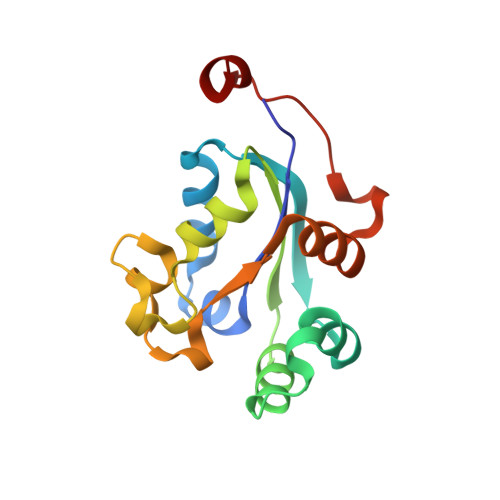Nucleotide Binding to Nucleoside Diphosphate Kinases: X-ray Structure of Human NDPK-A in Complex with ADP and Comparison to Protein Kinases
Chen, Y., Gallois-Montbrun, S., Schneider, B., Veron, M., Morera, S., Deville-Bonne, D., Janin, J.(2003) J Mol Biol 332: 915-926
- PubMed: 12972261
- DOI: https://doi.org/10.1016/j.jmb.2003.07.004
- Primary Citation of Related Structures:
1UCN - PubMed Abstract:
NDPK-A, product of the nm23-H1 gene, is one of the two major isoforms of human nucleoside diphosphate kinase. We analyzed the binding of its nucleotide substrates by fluorometric methods. The binding of nucleoside triphosphate (NTP) substrates was detected by following changes of the intrinsic fluorescence of the H118G/F60W variant, a mutant protein engineered for that purpose. Nucleoside diphosphate (NDP) substrate binding was measured by competition with a fluorescent derivative of ADP, following the fluorescence anisotropy of the derivative. We also determined an X-ray structure at 2.0A resolution of the variant NDPK-A in complex with ADP, Ca(2+) and inorganic phosphate, products of ATP hydrolysis. We compared the conformation of the bound nucleotide seen in this complex and the interactions it makes with the protein, with those of the nucleotide substrates, substrate analogues or inhibitors present in other NDP kinase structures. We also compared NDP kinase-bound nucleotides to ATP bound to protein kinases, and showed that the nucleoside monophosphate moieties have nearly identical conformations in spite of the very different protein environments. However, the beta and gamma-phosphate groups are differently positioned and oriented in the two types of kinases, and they bind metal ions with opposite chiralities. Thus, it should be possible to design nucleotide analogues that are good substrates of one type of kinase, and poor substrates or inhibitors of the other kind.
Organizational Affiliation:
Laboratoire d'Enzymologie et Biochimie Structurales, CNRS UPR 9063, 91198 Gif-sur Yvette, France.


















